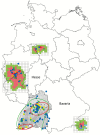The Citizen Science Project 'Mueckenatlas' Helps Monitor the Distribution and Spread of Invasive Mosquito Species in Germany
- PMID: 29029273
- PMCID: PMC5850493
- DOI: 10.1093/jme/tjx166
The Citizen Science Project 'Mueckenatlas' Helps Monitor the Distribution and Spread of Invasive Mosquito Species in Germany
Abstract
The citizen science project 'Mueckenatlas' (mosquito atlas) was implemented in early 2012 to improve mosquito surveillance in Germany. Citizens are asked to support the spatiotemporal mapping of culicids by submitting mosquito specimens collected in their private surroundings. The Mueckenatlas has developed into an efficient tool for data collection with close to 30,000 mosquitoes submitted by the end of 2015. While the vast majority of submissions included native mosquito species, a small percentage represented invasive species. The discovery of Aedes albopictus (Skuse) (Diptera: Culicidae), Aedes japonicus japonicus (Theobald) (Diptera: Culicidae) and Aedes koreicus (Edwards) (Diptera: Culicidae) specimens via the Mueckenatlas project prompted targeted monitoring activities in the field which produced additional information on the distribution of these species in Germany. Among others, Mueckenatlas submissions led to the detection of three populations of Ae. j. japonicus in West, North and Southeast Germany in 2012, 2013, and 2015, respectively. As demonstrated by on-site monitoring, the origins of Ae. j. japonicus specimens submitted to the Mueckenatlas mirror the distribution areas of the four presently known German populations as found by active field sampling (the fourth population already reported prior to the launch of the Mueckenatlas). The data suggest that a citizen science project such as the Mueckenatlas may aid in detecting changes in the mosquito fauna and can therefore be used to guide the design of more targeted field surveillance activities.
Keywords: Germany; Mueckenatlas; citizen science; invasive mosquitoes; passive mosquito surveillance.
© The Authors 2017. Published by Oxford University Press on behalf of Entomological Society of America.
Figures


References
-
- Becker N., Huber K., Pluskota B., and Kaiser A.. 2011. Ochlerotatus japonicus japonicus – a newly established neozoan in Germany and a revised list of the German mosquito fauna. Eur. Mosq. Bull 29: 88–102.
-
- Becker N., Petrić D., Zgomba M., Boase C., Madon M., Dahl C., and Kaiser A.. 2010. Mosquitoes and their control. 2nd ed. Springer, Heidelberg, Germany.
-
- Dahl C.I., Kaiser A., and Becker N.. 1999. Culicidae. In: Schuhmann H., Bährmann R., and Stark A. (eds), Checkliste der Dipteren Deutschlands. Studia Dipterol., Suppl. 2: 51–52.
-
- (ECDC) European Centre for Disease Prevention and Control 2012. Guidelines for the surveillance of invasive mosquito species in Europe. ECDC Technical Report, Stockholm, Sweden.
-
- Folmer O., Black M., Hoeh W., Lutz R., and Vrijenhoek R.. 1994. DNA primers for amplification of mitochondrial cytochrome c oxidase subunit I from diverse metazoan invertebrates. Mol. Mar. Biol. Biotechnol. 3: 294–299. - PubMed
Publication types
MeSH terms
LinkOut - more resources
Full Text Sources
Other Literature Sources
Medical
Research Materials

